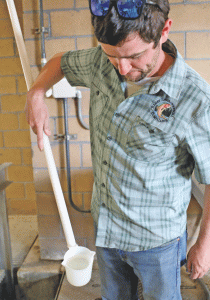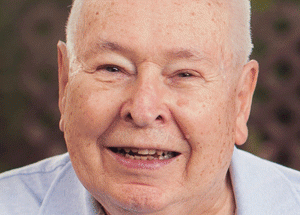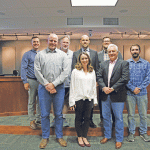Down the drain: The story of a flush, Part 2

Photos by Terry Georgia
Michael Murphy, of Ramey Environmental Compliance, Inc., and leader of Berthoud’s Wastewater Treatment Plant’s team, checks the water for clarity after it is treated and just before it is released into the Little Thompson River.
By Terry Georgia
The Surveyor
Last week’s tale of wastewater treatment in Berthoud reached its climax with Mike Murphy and his team of wastewater scientists carefully monitoring the activity and behavior of the microscopic “bugs” responsible for eating up the waste in over a million gallons of wastewater flushed down Berthoud drains every day. This week, the saga picks up as the team prevents possible disaster in the aeration tanks by sending over populations of the bugs to their next life via The Digesters.
The Digesters
As the bugs ingest the matter in the aeration basins they grow and continue to reproduce. Too many bugs in the system can upset the balance and cause additional problems, so excess bugs are harvested and sent to The Digesters. In these two 300-thousand-gallon tanks, the bugs have no access to the nutrients they need to reproduce. Bug survival mode kicks in and they begin eating each other. Their microscopic bodies retain quite a bit of water, so the bugs are also spun through a large centrifuge to salvage as much water from them as possible. This water is cycled back through the processing plant and treated again. Murphy says the centrifuges are the most cost-effective way to conserve as much water as possible in the process. The solids left over from the digesters are turned into Class B Biosolids that are used as an agricultural fertilizer in certain fields.
Murphy sometimes empathizes with the little critters. “The life of the bugs is pretty unpleasant,” he says, “They eat poop all day and might get eaten or spun through a centrifuge and end up as fertilizer.” But the work they do makes clean water possible.
Step 5. The Skimming Tanks
After sufficient time in the aeration basins the water, along with the bugs and their full tummies, are moved to skimming basins. The round skimming tanks are mostly still and quiet on the surface. Below, the bugs, having eaten their fill, sink to the bottom where they are collected to be used again.
The bugs can even process some soaps and chemicals, but can also be harmed by other chemical compounds. Grease and oils that float to the top of the water in these tanks are continually skimmed off the surface by long sweeping arms.
Step 6. The UV Light Treatment
In the last step of the treatment process, the water is disinfected by exposure to ultraviolet (UV) light. Many water treatment plants use chlorine to disinfect the water but Berthoud, preferring a more natural and minimally chemical process, prefers UV light. Murphy explained that the UV disinfects water by restructuring the DNA of harmful microorganisms, making the water safe to return to the natural ecosystem of the Little Thompson.
The entire treatment process takes only 24 hours.
Step 7. The Release
From there, the water is released directly into the river, which flows close to the plant. According to Murphy, the water being released into the Little Thompson is cleaner than the water already flowing there.
Throughout treatment, dozens, if not hundreds, of tests are run by plant personnel and outside labs to ensure the process is running efficiently and the bugs are performing as they should. The entire system is self-sustaining. The Environmental Protection Agency (EPA) and the state set the standards for wastewater treatment and the Colorado Department of Health monitors the process to ensure standards are being met. Tests are run throughout the plant and in the river.
Murphy says the regulations continue to get tighter and the Town of Berthoud is constantly having to upgrade the system to comply with new regulations and to meet increasing demand. “A lot of money and effort is put into keeping the system running well,” he said, because the town is committed to maintaining the most cost-efficient, sustainable process possible. “It’s expensive,” he explains, “but the average household uses about 100 gallons of water every day. If they had to pay to have that water delivered and pay to have two huge barrels of wastewater hauled off every day, suddenly the system we have looks very, very cost-effective.”
“No Flushable Wipes!”
At the end of the tour, the plant crew was asked what advice they had for Berthoud residents. In perfect unison, they all shouted, “NO FLUSHABLE WIPES!” Apparently, these ubiquitous sheets are a bane to the entire system because they do not break down easily and cause countless headaches.
Grease, oils and even food waste coming through garbage disposals cause problems too. Murphy and his team would prefer that residents throw food waste into the garbage or preferably use compost bins. “The more materials we have to remove, the more expensive and less sustainable the system becomes.,” says Murphy.
He also cautions that storm drains are not connected to the wastewater system, so anything sent down gutters and street drains flows directly into natural water sources without being treated. Murphy says that chemicals, fertilizers, pet excrement and trash don’t belong in the storm sewer. And, he emphasizes, “Do not treat your toilets like a garbage can. The only thing that should be going down the drain is the 3 P’s.”
Wastewater treatment teams sometimes find unusual things that have managed to make their way through the system. Toys and syringes top the list, but they have also found gold chains, a gigantic pair of underwear and one time, hundreds of livers. They tell the tale of a Denver wastewater plant that discovered metal plates for printing counterfeit $100 bills. Perhaps the result of a quick flush during a raid? There’s no way to know. Cleaning the filters can be one of the more adventurous parts of the job.
The treatment of wastewater is becoming more and more critical as water becomes harder to get in the coming years. Drought, climate change and living in a dry climate are all threats to obtaining clean water in the future. Conserving this resource in every possible way is already a necessity. The devoted team at the Berthoud Wastewater Treatment Plant is doing its best to ensure our waste does not squander our most precious resource.
- July, 08 2015

Robert Preston Dunlap: June 13, 1962 ...
Robert Preston Dunlap, 53, fought the fight and went home to be with God peacefully,...
- May, 26 2017

Obituary – Ivan E. Majors
Ivan E. Majors Oct. 2, 1933 — May 16, 2017 Ivan...
- March, 08 2017

Community Calendar March 9
Community Calendar March 9
- October, 25 2023

Town board makes appointments and sig...
By Brendan Henry The Surveyor Berthoud’s Board of Trustees held their regularly scheduled meeting...
- August, 26 2015

Carolyn Marie Boettcher-Schultz: Sept...
Carolyn Marie Boettcher-Schultz, 88, died peacefully at her home in Berthoud, Colo., on Aug. 6...
- January, 03 2020


Unified basketball comes to Turner Middle School
Community News

Mike Grace says goodbye as Brett Wing joins town board
Community News
POLICEBLOTTER
Community News
Northern Water sets C-BT quota at 70% for 2024
Community News

Emotions run high during Revere Property hearing
Community News
Snowpack at 119% above normal
Community News

Karspeck to serve third term as Berthoud mayor
Community News
COMMUNITY CALENDAR:
Community Calendar – add an event
Homestead Fine Art Gallery First Fridays OPEN HOUSE
03 May 4:00 PM - 7:00 PM
Homestead Fine Art Gallery First Fridays OPEN HOUSE
07 Jun 4:00 PM - 7:00 PM
Homestead Fine Art Gallery First Fridays OPEN HOUSE
05 Jul 4:00 PM - 7:00 PM
Homestead Fine Art Gallery First Fridays OPEN HOUSE
02 Aug 4:00 PM - 7:00 PM
Homestead Fine Art Gallery First Fridays OPEN HOUSE
06 Sep 4:00 PM - 7:00 PM
Homestead Fine Art Gallery First Fridays OPEN HOUSE
04 Oct 4:00 PM - 7:00 PM




